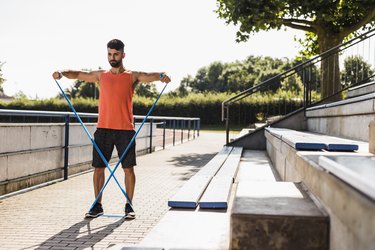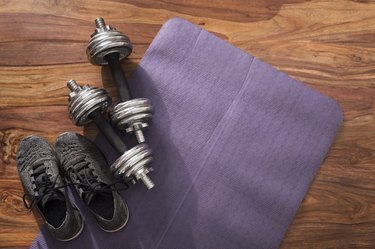
Gone are the days when strength training was just for bodybuilders and pro athletes. In fact, the Physical Activity Guidelines for Americans from the U.S. Department of Health and Human Services recommend that all of us should strength train at least twice a week.
Our goals can still differ plenty over those two (or more) weekly strength sessions. For some people, strength training is all about sculpting enviable muscle tone and size to show off in gym selfies. For others, it's about building balance, improving mobility or having an easier time heaving a carry-on suitcase into an overhead compartment.
No matter your aim with strength training (also known as resistance training), the key concept remains true: To get stronger, you need to put a load on your muscles. That stimulates them to adapt and become stronger, especially as you increase the load or resistance over time.
The best part: While resistance bands, dumbbells, kettlebells and barbells all up the intensity of strength-training workouts, you can challenge yourself plenty with just your body weight. Here, find all the convincing evidence on the importance of strength training and how to get started.
The Many Benefits of Strength Training

Experts don't recommend lifting weights at least twice a week because we should all aspire to bulging biceps or chiseled abs — although strength training can and will change the appearance of your muscles. Instead, that suggestion comes from all the additional benefits of resistance training, like a healthier heart, higher self-esteem and better performance on the soccer field, basketball court or track.
"Moderate levels of strength benefit almost any activity, whether athletic or part of everyday living," says Jason Li, CPT, personal training manager at SoHo Strength Lab in New York City. "Name any activity and strength training will most likely be beneficial in some way."
Learn how strength training can benefit your body and mind, no matter what equipment you use.
Why Even Beginners Should Try Strength Training

Seeing athletes at the top of their game pumping iron can make strength training seem intimidating for beginners. But you don't need a lot of equipment or a laundry list of exercises; most trainers will make sure you don't overcomplicate your workouts, especially in your first few sessions.
The best place for beginners to start is with a combination of body-weight and dumbbell moves (more on both below!) and a solid foundation of basic tips on safety and technique.
Here's exactly how to get started with strength training.
How to Strength Train at Home

Many people picture an unwelcoming weight room tucked in the back of a gym when they think about strength training. While we believe in finding a gym where you feel comfortable doing your thing, you may just feel better strength training in the comfort of your own living room or garage — at least until it's time to progress to heavier weights than you'd find in the typical home gym.
A suspension system like TRX or a set of resistance bands will come in handy if you want to strength train at home, as will dumbbells in a couple of different weights — a relatively inexpensive investment that will serve you well for workouts to come.
Combine these five exercises for a simple at-home strength-training routine.
Body-Weight Exercises to Build Strength

Yes, you can get stronger with zero equipment. Body-weight movements like squats, mountain climbers and push-ups can help you burn calories, shed body fat and build muscle — and you can do them just about anywhere.
"Body-weight exercises can definitely help you get fit without a gym," says Gretchen Raddatz, CPT, master coach for Row House. "All you need is a little space."
Start with 8 to 10 reps of three of your favorite body-weight moves to create your own circuit, and remember to still take days off, Raddatz says. She recommends giving your muscles 48 hours of rest between higher-intensity body-weight workouts.
Mix and match from this list of the 18 best body-weight exercises for your next equipment-free strength-training session.
The Best Resistance Band Strength-Training Exercises

Resistance bands are portable, inexpensive and adaptable; you can use them nearly anywhere to add variety to your strength-training routine, which keeps your muscles growing by challenging them in new ways.
"With free weights, the force is always downward, and we're fighting to move up, but with resistance bands, we can change up the lines of force," K. Aleisha Fetters, CSCS, tells LIVESTRONG.com. "Also, resistance bands provide variable resistance: How hard we have to work changes as we stretch the band in each rep, which is another way to mix things up."
With a couple of bands in different sizes and levels of resistance, you'll be able to recreate a wide range of traditional gym exercises, like lat pulldowns, good mornings and overhead presses.
Invest in a band or two and give this full-body resistance band workout a try.
How to Strength Train With Dumbbells

Thanks to their many different shapes, sizes and weights, dumbbells make it (relatively) straightforward for beginners and experienced lifters alike to strengthen from head to toe.
Plus, they're the perfect tool for continuing to challenge yourself as you get stronger, a concept known in the strength-training world as progressive overload. The idea is to gradually increase the stress on your body, which forces your muscles to adapt and grow stronger in response.
Building that kind of strength takes a little fine-tuning. As your dumbbell workouts progress, you'll need to tweak the basic structure of reps and sets to continue toward your goals.
Target all your major muscle groups with these five essential dumbbell exercises.
The Best Kettlebell Exercises for Strength

Kettlebells earned their trendy reputation for good reason: The funky-shaped weights are impressively versatile.
"Not only can kettlebell workouts build strength and endurance, but they are great for balance, stability and coordination," says Katie Kollath, CPT, founder of Barpath Fitness. "In fact, you can get in a great workout with just a single kettlebell."
Don't be intimidated by the unusual moves people do with them, though. "Beginners can and should use kettlebells," Kollath says. With a little form practice — and patience — even newbies can build muscle mass, gain strength and shed body fat with kettlebells.
Try some of these 12 kettlebell exercises you're probably not doing.